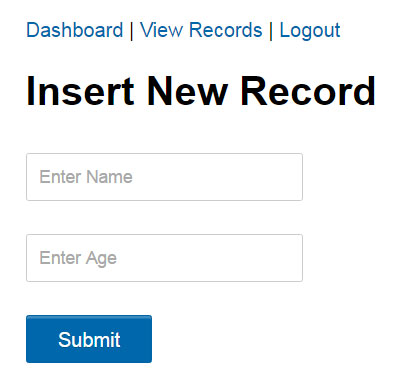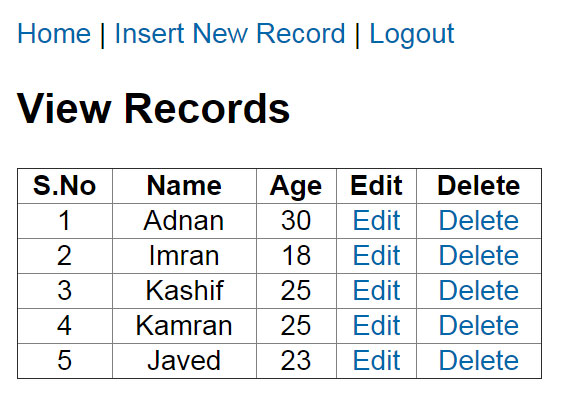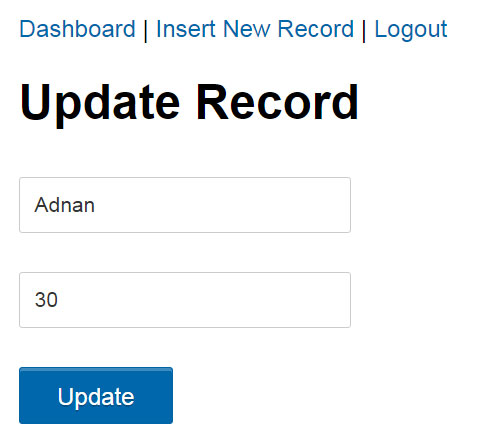4E e 5E SIA: Inserisci, visualizza, modifica ed elimina record dal database utilizzando PHP e MySQLi con file zippato della procedura
Inserisci, visualizza, modifica ed elimina record dal database utilizzando PHP e MySQLi e file zippato
Link originale: https://www.allphptricks.com/insert-view-edit-and-delete-record-from-database-using-php-and-mysqli/
In questo tutorial, spiegherò come inserire,
visualizzare, modificare ed eliminare record dal database utilizzando PHP e
MySQLi, in pratica questo tutorial è una seconda parte di Simple User Registration & Login Script in PHP e
MySQLi , in questa prima parte ho spiegato come per creare
una semplice registrazione utente e accedere utilizzando PHP e MySQLi, se non
sai come creare la registrazione utente e il modulo di accesso utente, quindi
prima controlla questo tutorial Registrazione utente semplice e script di accesso in PHP e MySQLi ,
dopodiché ora torna a questo tutorial.
Sto usando PHP 5.6 per questo
tutorial, non ho controllato questo tutorial su PHP 7, assicurati gentilmente
di utilizzare PHP 5.6 per evitare errori imprevisti.
Ti suggerirei di controllare PHP CRUD Operations Using PDO Prepared Statements ,
poiché è compatibile con PHP 7 e 8 entrambi.
Passaggi per creare un
record di inserimento, visualizzazione, modifica ed eliminazione dal database
utilizzando PHP e MySQLi
Ora presumo che tu abbia già creato la registrazione
dell'utente e i moduli di accesso che ho creato in Simple User Registration & Login Script in PHP e MySQLi ora
creerò un'altra tabella per conservare i record, aggiornerò il file dashboard.php e
aggiungerò altri quattro nuovi pagine che sono insert.php, view.php,
edit.php e delete.php , procedi nel seguente modo:
1. Crea un'altra tabella
per i record
2. Aggiorna file
dashboard
3. Crea pagina di
inserimento
4. Crea Visualizza pagina
5. Crea pagina
Modifica/Aggiorna
6. Crea Elimina pagina
1. Creare un'altra
tabella per i record
Esegui la seguente query SQL:
CREATE TABLE IF NOT EXISTS `new_record` (
`id` int(11) NOT NULL AUTO_INCREMENT,
`trn_date` datetime NOT NULL,
`name` varchar(50) NOT NULL,
`age`int(11) NOT NULL,
`submittedby` varchar(50) NOT
NULL,
PRIMARY KEY (`id`)
);
2. Aggiorna la pagina
del dashboard
Aggiorna il file dashboard.php e
incolla il seguente codice al suo interno.
<?php
require('db.php');
include("auth.php");
?>
<!DOCTYPE html>
<html>
<head>
<meta charset="utf-8">
<title>Dashboard
- Secured Page</title>
<link rel="stylesheet" href="css/style.css" />
</head>
<body>
<div class="form">
<p>Welcome
to Dashboard.</p>
<p><a href="index.php">Home</a><p>
<p><a href="insert.php">Insert New
Record</a></p>
<p><a href="view.php">View Records</a><p>
<p><a href="logout.php">Logout</a></p>
</div>
</body>
</html>
3. Creare una pagina
di inserimento
Crea una pagina con il nome insert.php e
incolla il codice qui sotto.
<?php
require('db.php');
include("auth.php");
$status = "";
if(isset($_POST['new']) && $_POST['new']==1){
$trn_date = date("Y-m-d H:i:s");
$name =$_REQUEST['name'];
$age = $_REQUEST['age'];
$submittedby = $_SESSION["username"];
$ins_query="insert into new_record
(`trn_date`,`name`,`age`,`submittedby`)values
('$trn_date','$name','$age','$submittedby')";
mysqli_query($con,$ins_query)
or die(mysql_error());
$status = "New Record Inserted Successfully.
</br></br><a
href='view.php'>View Inserted Record</a>";
}
?>
<!DOCTYPE html>
<html>
<head>
<meta charset="utf-8">
<title>Insert
New Record</title>
<link rel="stylesheet" href="css/style.css" />
</head>
<body>
<div class="form">
<p><a href="dashboard.php">Dashboard</a>
| <a href="view.php">View Records</a>
| <a href="logout.php">Logout</a></p>
<div>
<h1>Insert
New Record</h1>
<form name="form" method="post" action="">
<input type="hidden" name="new" value="1" />
<p><input type="text" name="name" placeholder="Enter Name" required /></p>
<p><input type="text" name="age" placeholder="Enter Age" required /></p>
<p><input name="submit" type="submit" value="Submit" /></p>
</form>
<p style="color:#FF0000;"><?php echo $status; ?></p>
</div>
</div>
</body>
</html>
4. Crea Visualizza
pagina
Crea una pagina con il nome view.php e
incolla il codice qui sotto.
<?php
require('db.php');
include("auth.php");
?>
<!DOCTYPE html>
<html>
<head>
<meta charset="utf-8">
<title>View
Records</title>
<link rel="stylesheet" href="css/style.css" />
</head>
<body>
<div class="form">
<p><a href="index.php">Home</a>
| <a href="insert.php">Insert New
Record</a>
| <a href="logout.php">Logout</a></p>
<h2>View
Records</h2>
<table width="100%" border="1" style="border-collapse:collapse;">
<thead>
<tr>
<th><strong>S.No</strong></th>
<th><strong>Name</strong></th>
<th><strong>Age</strong></th>
<th><strong>Edit</strong></th>
<th><strong>Delete</strong></th>
</tr>
</thead>
<tbody>
<?php
$count=1;
$sel_query="Select * from new_record ORDER BY
id desc;";
$result = mysqli_query($con,$sel_query);
while($row = mysqli_fetch_assoc($result))
{ ?>
<tr><td align="center"><?php echo $count; ?></td>
<td align="center"><?php echo $row["name"]; ?></td>
<td align="center"><?php echo $row["age"]; ?></td>
<td align="center">
<a href="edit.php?id=<?php echo $row["id"]; ?>">Edit</a>
</td>
<td align="center">
<a href="delete.php?id=<?php echo $row["id"]; ?>">Delete</a>
</td>
</tr>
<?php $count++; } ?>
</tbody>
</table>
</div>
</body>
</html>
5. Crea pagina
Modifica/Aggiorna
Crea una pagina con il nome edit.php e
incolla il codice qui sotto.
<?php
require('db.php');
include("auth.php");
$id=$_REQUEST['id'];
$query = "SELECT * from new_record where
id='".$id."'";
$result = mysqli_query($con, $query) or die ( mysqli_error());
$row = mysqli_fetch_assoc($result);
?>
<!DOCTYPE html>
<html>
<head>
<meta charset="utf-8">
<title>Update
Record</title>
<link rel="stylesheet" href="css/style.css" />
</head>
<body>
<div class="form">
<p><a href="dashboard.php">Dashboard</a>
| <a href="insert.php">Insert New
Record</a>
| <a href="logout.php">Logout</a></p>
<h1>Update
Record</h1>
<?php
$status = "";
if(isset($_POST['new']) && $_POST['new']==1)
{
$id=$_REQUEST['id'];
$trn_date = date("Y-m-d H:i:s");
$name =$_REQUEST['name'];
$age =$_REQUEST['age'];
$submittedby = $_SESSION["username"];
$update="update new_record set
trn_date='".$trn_date."',
name='".$name."', age='".$age."',
submittedby='".$submittedby."' where id='".$id."'";
mysqli_query($con, $update) or die(mysqli_error());
$status = "Record Updated Successfully.
</br></br>
<a
href='view.php'>View Updated Record</a>";
echo '<p
style="color:#FF0000;">'.$status.'</p>';
}else {
?>
<div>
<form name="form" method="post" action="">
<input type="hidden" name="new" value="1" />
<input name="id" type="hidden" value="<?php echo $row['id'];?>" />
<p><input type="text" name="name" placeholder="Enter Name"
required value="<?php echo $row['name'];?>" /></p>
<p><input type="text" name="age" placeholder="Enter Age"
required value="<?php echo $row['age'];?>" /></p>
<p><input name="submit" type="submit" value="Update" /></p>
</form>
<?php } ?>
</div>
</div>
</body>
</html>
6. Crea Elimina pagina
Crea una pagina con il nome delete.php e
incolla il codice qui sotto.
<?php
require('db.php');
$id=$_REQUEST['id'];
$query = "DELETE FROM new_record WHERE id=$id";
$result = mysqli_query($con,$query) or die ( mysqli_error());
header("Location:
view.php");
?>







Commenti
Posta un commento